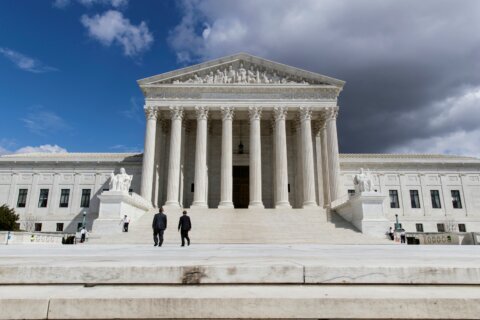WASHINGTON (AP) — Oh, those charts.
President Donald Trump passed one around on Twitter in recent days, and it showing spending on Medicaid rising for years in the future under the stalled Republican health care bill. You’d never know from his chart’s mountain-climbing line , or his rhetoric, that the bill would inflict deep cuts in the program.
A drawing can be made to show what the person making the display wants people to see, even using correct numbers, but in a way that obscures reality. Similarly, Vice President Mike Pence had a chart onstage weeks ago showing how enrollment under the Obama-era health law fell far short of predictions. That’s only because Pence and his chart ignored the estimated 12 million low-income people covered under the overhaul’s Medicaid expansion.
Trump’s tweet came during a week of tussling over the Senate Republican health bill, a White House cheerleading session for U.S. energy and assertions by the president on trade — subjects producing a variety of statements that call for scrutiny.
A sampling:
TRUMP: “For many, many years, the United States has suffered through massive trade deficits. That’s why we have $20 trillion in debt. So we’ll be changing that.” — Remarks Friday in meeting with South Korean President Moon Jae-in and aides.
THE FACTS: Trump’s comments suggest he could use a refresher in how the economy works. Trade deficits are not why the U.S. has nearly $20 trillion in national debt.
Because the U.S. imports more than it exports, it has a negative trade balance, or a deficit. Of course, many of the goods that the U.S. imports are popular with consumers so a deficit isn’t necessarily negative. Americans may buy coffee from Central America, electronics from China, cars from South Korea and jeans sewn in Turkey.
The national debt is a separate thing. It’s the debt accumulated from budget deficits year after year, when the federal government must borrow because it spends more than it collects in taxes. The total public debt outstanding is $19.8 trillion.
If Trump seeks to reduce that figure, he would probably need to do some combination of cutting spending, increasing tax revenues and fueling significantly faster economic growth.
___
TRUMP: “Democrats purposely misstated Medicaid under new Senate bill – actually goes up.” — tweet Wednesday, with chart.
KELLYANNE CONWAY, White House senior adviser: “These are not cuts to Medicaid, George. This slows the rate for the future and it allows governors more flexibility with Medicaid dollars because they’re closest to the people in need.” — Sunday on ABC’s “This Week.”
THE FACTS: The stalled Senate bill would cut Medicaid — by phasing out ex-President Barack Obama’s expansion of the program and reducing over time the number of people who can be on it.
The nonpartisan Congressional Budget Office estimates the program would cover 15 million fewer people by 2026, a 16 percent reduction. Although Trump and Conway are correct that Medicaid spending overall would continue to rise, and at a slower rate than projected, the effect would be a significant cut in the program.
Governors would have more flexibility, but they also would have to dig deeper into their state budgets to make up missing money from Washington or scale back the program.
The Republican emphasis on spending growth is a sleight of hand that both parties resort to when it suits their political purposes.
Obama’s law slowed the growth of Medicare spending, primarily by reducing projected payment increases to hospitals and other providers, and Republicans roundly denounced that as the cut that it was.
___
TRUMP: “Our new American Energy Policy will unlock MILLIONS of jobs & TRILLIONS in wealth. We are on the cusp of a true energy REVOLUTION.” — tweet Friday.
THE FACTS: It’s hard to see how any government policy could yield the results Trump predicts. Despite a recent boom, the energy sector employs fewer workers than it did a decade ago. The Labor Department said there are 655,300 jobs in mining coal and extracting oil and natural gas, down from a peak of 1.18 million jobs in 1981. And a report in January from the authoritative Energy Information Administration shows that the entire energy generation sector – including solar, wind, hydroelectric, nuclear and bioenergy – employs 2 million people.
___
TRUMP: “As you all know, I approved the Keystone XL pipeline and the Dakota Access pipeline in my first week. Thousands of jobs, tremendous things are happening.” — remarks Thursday on energy.
THE FACTS: His timing is off and his boast about jobs leaves out the fact that almost all the employment is temporary.
In his first week, Trump signed orders asking TransCanada to resubmit its application to build Keystone XL and requiring the Army Corps of Engineers to reconsider its earlier refusal to grant an easement needed to finish the Dakota Access project. Both projects had been blocked by the Obama administration and Trump undoubtedly revived them, but his Jan. 24 orders did not approve them. That came later.
The U.S. government estimated Keystone XL will create 42,100 jobs directly and indirectly in the U.S. for up to two years. Once the pipeline is complete, operating it would support an estimated 50 jobs. The recently completed Dakota Access pipeline is expected to support several dozen permanent jobs.
___
TRUMP, on how he braced for trouble when he revived the pipeline projects: “I thought I’d take a lot of heat. I didn’t take any heat. I approved them and that was it. I figured we’d have all sorts of protests. We didn’t have anything.” — remarks on energy.
THE FACTS: Hundreds of authorities went into the Standing Rock protest camp in late February, clearing it out and arresting 46 people. Trump is wrong to say there were no protests. But they were much diminished by the time he took his action. Protesters had declared victory in December when the Army Corps ruled against the easement, freezing the project. The Standing Rock Sioux, the tribe at the center of the protests in North Dakota, told demonstrators through the winter that it was time to go home.
___
TRUMP: “The #AmazonWashingtonPost, sometimes referred to as the guardian of Amazon not paying internet taxes (which they should) is FAKE NEWS!” — tweet Wednesday.
THE FACTS: This convoluted accusation of fake news from The Washington Post sideswipes Amazon for supposedly not paying “internet taxes,” which are not really a thing. In any event, Amazon.com collects state sales taxes in all 45 states that have such taxes, as well as the District of Columbia, according to its website. State governments have sought to capture sales taxes lost to internet retailers, though they have struggled with a 1992 Supreme Court ruling that retailers must have a physical presence in a state before officials can make them collect sales tax.
Amazon CEO Jeff Bezos bought The Washington Post in 2013, without the involvement of Amazon.com Inc.
___
HOUSE SPEAKER PAUL RYAN, R-Wis.: “They want government-run health care. Government-run health care is collapsing as we speak. It’s not working.” — Fox News interview on Tuesday.
THE FACTS: Obama’s overhaul is not government-run health care like many other economically advanced countries have, but a U.S.-style hybrid involving the government, private companies and individuals.
His law kept the system centered on private insurance companies, doctors in private or group practice and employer-subsidized coverage, with new subsidies for private insurance and an expansion of the government-financed Medicaid program that’s been in place since 1965.
Obama introduced more standards and controls, like the prohibition on denying insurance to sick people, which Republicans want to maintain. Most Democrats are not pushing for a single-payer system of universal coverage with the government paying for the care.
___
REP. KATHY CASTOR, D-Fla.: “Most children in the country receive their basic medical care through Medicaid. And if a child is born with a complex condition or, God forbid, your child is diagnosed with childhood cancer, it’s Medicaid that makes sure that you not live a life of poverty.” — remarks to media Tuesday.
THE FACTS: More children are covered by private insurance than by Medicaid. Employer-based and other private plans cover 54 percent of children and Medicaid covers 39 percent, according to 2015 statistics from the Kaiser Family Foundation.
Also, Medicaid is not designed as an escape from poverty. The health coverage is generally only a safety net for those who are on it. It doesn’t catch low-income people who suddenly face catastrophic costs driving them into poverty. They have to be poor to qualify for Medicaid.
___
SEN. RAND PAUL, R-Ky.: “President Obama, I thought, was trying to do the best for people. He really did try to help get more people health care. It didn’t work but I don’t think he was trying to kill people.” — Fox News interview Tuesday.
THE FACTS: Obama did more than try to expand health care. Millions of Americans gained coverage either through the health care law’s insurance exchanges — most of it subsidized — or through the expansion of Medicaid in states that opted to do so with additional federal money. The uninsured rate dropped to a historic low, about 9 percent.
It’s also premature to conclude that the law “didn’t work,” as Paul asserted. Premiums have risen, in some states dramatically, and coverage choices have dwindled in many areas. But the most recent assessment by the Congressional Budget Office found that the law’s exchange markets are “stable” overall. And Republican governors who have adopted Obama’s Medicaid expansion are lobbying to preserve it.
___
SARAH HUCKABEE SANDERS, White House spokeswoman, on why she thinks the Congressional Budget Office is credible on matters involving revenue and spending but not reliable in predicting 22 million people would lose coverage under the Republican bill: “The CBO is a budget office … We don’t always agree that it does a great job predicting coverage.” She added: “I think when they focus on the budget side, that’s probably a good thing.” — briefing Tuesday.
THE FACTS: She’s cherry-picking. It’s a Washington ritual to talk up favorable findings from the CBO and talk down negative ones.
She likes the office’s budget projections because they anticipate a cut in the deficit and health-related taxes as a result of the legislation. She dislikes the nonbudget projections that anticipate a substantial rise in the uninsured.
But the two cannot be unlinked: A law’s effects on the budget can only be forecast if analysts make assumptions on how that law changes people’s behavior. The expectation that fewer people would buy health insurance under the Republican bill is central to measuring the bill’s impact on federal finances.
The CBO is highly respected on Capitol Hill for its impartiality, and its projections, while sometimes far off, are considered more reliable than those by other analysts. But that doesn’t stop partisans from assailing the office’s credibility when it suits them — Democrats did the pummeling when they didn’t like CBO forecasts on Obama’s law.
As Republican Sen. Lindsey Graham of South Carolina put it earlier this year: “We like the CBO when they agree with us. When they don’t, they’re a bunch of losers.”
___
SEN. PAT ROBERTS, R-Kan., reaching for an analogy to illustrate how difficult it is to negotiate health care: “Once in Glacier National Park I saw two porcupines making love. I’m assuming they produced smaller porcupines. They produced something. It has to be done carefully. That’s what we’re doing now.” — after GOP luncheon Wednesday.
THE FACTS: He is correct, porcupine mating is tricky and potentially prickly. But, unlike lawmakers, porcupines have their mission figured out.
Porcupine spines are an intimidating mechanism to protect the animals from predators. But when it comes time to mate, they have the ability to let down their defenses, said Duke University biologist Stuart Pimm. Courtship rituals can be aggressive but when the animals have negotiated the art of the deal, the females relax and reposition their quills.
It’s not entirely different from people, Pimm said. “We humans are quite capable of arming ourselves with the most ferocious weaponry but I don’t take my broadaxe to bed with me.”
___
Associated Press writers Josh Boak, Seth Borenstein, Ricardo Alonso-Zaldivar and Andrew Taylor in Washington; Blake Nicholson in Bismarck, North Dakota, and Doug Glass in Minneapolis contributed to this report.
___
Find AP Fact Checks at http://apne.ws/2kbx8bd
EDITOR’S NOTE _ A look at the veracity of claims by political figures
Copyright © 2025 The Associated Press. All rights reserved. This material may not be published, broadcast, written or redistributed.







